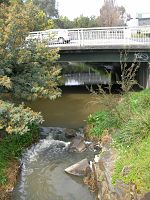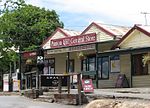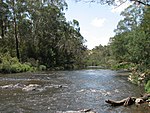Sugarloaf Reservoir
1981 establishments in AustraliaDams completed in 1981Embankment damsMelbourne Water catchmentReservoirs in Victoria (state) ... and 3 more
Rivers of Greater Melbourne (region)Use Australian English from July 2023Yarra Ranges Shire

Sugarloaf Reservoir is a reservoir at Christmas Hills 35 km north-east of the Melbourne central business district.
Excerpt from the Wikipedia article Sugarloaf Reservoir (License: CC BY-SA 3.0, Authors, Images).Sugarloaf Reservoir
Simpson Road, Melbourne Christmas Hills
Geographical coordinates (GPS) Address Nearby Places Show on map
Geographical coordinates (GPS)
| Latitude | Longitude |
|---|---|
| N -37.6749 ° | E 145.3051 ° |
Address
Simpson Road
Melbourne, Christmas Hills
Victoria, Australia
Open on Google Maps




